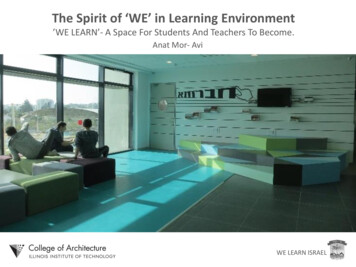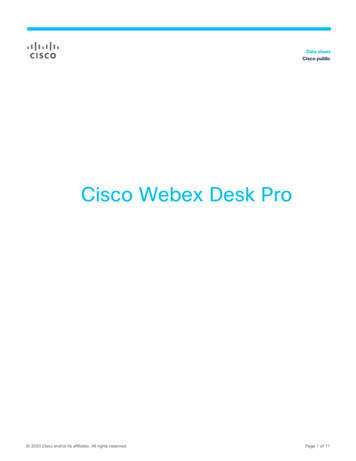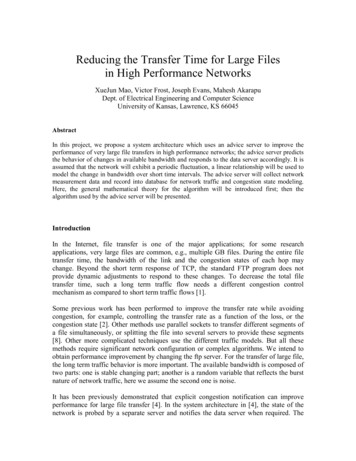
Transcription
The Spirit of ‘WE’ in Learning Environment’WE LEARN’- A Space For Students And Teachers To Become.Anat Mor- AviWE LEARN ISRAEL
“It is a HISTORICAL MOMENT””“Learning Environments For Tomorrow”SymposiumHarvard Graduate School of EducationArchitect Jonatan LeviMarch 2017
.and teachersteach stuff“School is NOT a place where students learn stuffis the place where they BECOME”“Learning Environments for Tomorrow”SymposiumHarvard Graduate School of EducationDr. Daniel WilsonMarch 2017, it
WHY?isLinearToward Creative Learning Spaces, 2011 by Joe BoysCreative schools -The Grassroots Revolution That’s transforming Education 2015 by Sir Ken Robinson
HOW“When we collaborate, creativity unfoldsacross people; the sparks fly faster, and thewhole is greater than the sum of its parts,”Keith SawyerGroup Genius 2007"Rather than attempt to develop educationalstructures that increase individual student creativity it is more important to pursue an understanding ofthe unique learning that occurs to young peoplewhen they participate in the development of groupgenerated creative ideas. "Dr. Edward Clapp2017 Harvard
WHYCreativity as asocialprocessNeweducationalapproachesSense ofcommunityCollaborationWhile the technology and knowledge about how we learn impacts learning and the learner, it is alsoimpacting the importance of social values in schools (Scott-Webber, 2014).The culture of collaboration of teachers and students in learning environments is in constantchange. This process is complex and includes many old paradigms that should be abandonedby the students, the teachers and the entire community (Scott-Webber, 2017).
HOWCreativity is a socially distributed and participatory processWE I/ME
HOW2 ‘WE’ CommunitiesMe&MyThoughtsThe Student’s WEThe ‘WE’s Layers in learning processes
HOWMEvsTHEM21st CenturyThe NET ParadigmIn the 21st Century, teachers are a community of learners and the teacher's tendency to workand teach in isolation is no longer suitable and/or effective (Glaze, 2014).
HOWHow can Architecture influence Creativity?In Genius: A crash course in Creativity by Dr. Tina Seeing
HOW22‘WE’ F ( P; C; E )
WHAT What are the architectural and design attributes that impactstudent and teacher success in relation to school culture, ingCOLLABORATION & CREATIVITY? Do those design attributes actually lead to a more collaborativeexperience of both group users equally? Are there differences between the attributes designed for teachers vs. students?
WHATTeachers - Teachers’WEHUBStudents - Students’WEHUBLearning DoingLearning FacilitatingLearning WorkingStudents’ & Teachers’WEHUBThe2 1 WEHUB Model
An Academic Park in Ganey Tikva, Israel – A Glance On a Process of Change:From Small Gestures To New Paradigm213By Eliakim Architects Israel1. Eylot Elementary School - 20162. Mietar High School - 2016, 20173. New Middle school - 2018The3WE Model
BRIDGING THE GAP BETWEEN DESIGN & RESEARCHDesign Responds ers fromOther disciplines,mostlyfrom Hi-Techdomains@ Mietar HS2016-172017Users and official’sresponsesand involvementThe developmentof a Hi-Tech culture inschoolsMeitar HS -futurepedagogical lab3New MiddleSchoolR2 1 acher’s WEexperienceas learnersand facilitators?In the learningenvironments@ Meitar HSand theNEW MiddleSchool2017-20
An Academic Park in Ganey Tikva Israel – A Glance on a Process of Change:Mietar High School - 2016, 2017
An Academic Park in Ganey Tikva Israel – A Glance On a Process of Change:Eylot Elementary-Early 20161STSSMietar High School-2016,20172TSTTEACHERS’ WE LEARN; WE WORKSSTUDENT’S WE LEARNThe3TheWE Model3SWE Model
An Academic Park in Ganey Tikva Israel – A Glance On a Process of Change:The New Middle School - 20183T2 1 WEHUB MODELSS TTTTEACHERS’ WE LEARN; WE WORKSSTUDENT’S WE LEARNThe3WE Model
BRIDGING THE GAP BETWEEN DESIGN & RESEARCHNEW MSMIETAR HS
Thank YouTransitionsAnat Mor-AviWE LEARNwww.welearnISRAEL.comanat.moravi1@gmail.com
Creative schools -The Grassroots Revolution That [s transforming Education 2015 by Sir Ken Robinson Toward Creative Learning Spaces, 2011 by











